0n March 20 1879, the first three Brothers came to the district called “Beirstoppel” which was situated on the left bank of the Schelde in Wetteren, to lead an orphanage over there. It later became the prosperous Scheppers Institute that was called originally “The Saint Barbara Institute”.
The Beginning of the 20th Century
In 2004 The Scheppers Institute in Wetteren celebrated its 125th birthday. In 2018 the Institute had 242 staff members and 1571 pupils, spread over two settlements and divided as follows: 137 kiddies, 245 primary school children and 1189 pupils in the technical school. So, to receive all those pupils, it became a necessity during these last years to build and to adapt constantly.
The New Main building and Workrooms
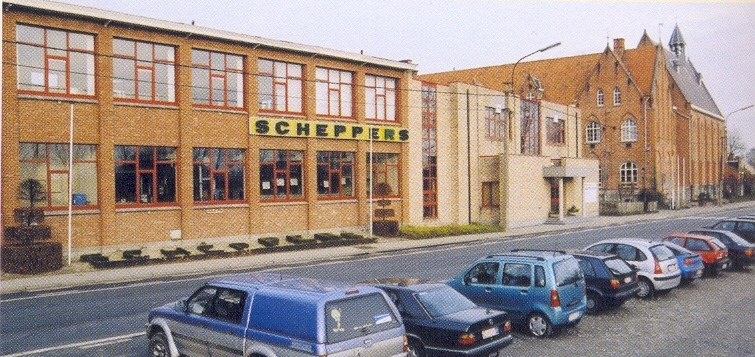
In the summer of 1992 a building from 1898 was demolished; before it was used for administrative services and part of the kitchen was also situated over there. In February 1994 the new building that was constructed upon the open space, was finished. In there a new reception was built as well as offices, a new main entrance, meeting rooms, a polyvalent hall/ restaurant, computer classes, a scientific room and a modern kitchen.
In may 1995 the construction of two working rooms started; each of them should be 900 square meters. In 1996 a new hangar was built for the horticultural division.
A new foot field and a new playground
In 2001, at the north side of the Institute, and along the “Stooktestreet”, a new foot field was laid out. At the end of 2003 the playground of the technical school was remade. The old sanitary block was demolished and benches as well as a green belt took its place. The pupils as well as the teachers of the different divisions realized a modern sanitary block and a beautiful flower and plants surrounding.
Fire in the Institute and a remake
24th June 2000 at 4.30’ in the morning, there was a fire in the Scheppers Institute. The teachers room and the porch went up in flames. The superior rooms had become useless and about 30 class rooms had smoke or water damage.
The teachers’ room was rebuilt by the pupils and the teachers of the Construction division, the wood and the electricity division, the central heating and the sanitary division in 2003-2004.
It all started with a Gunpowder Factory
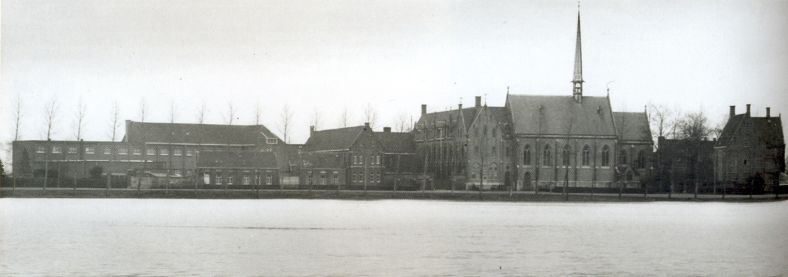
20th march 1879 the first three Brothers came to the district “Beirstoppel”, situated on the left bank of the Schelde in Wetteren. The history of the Saint-Barbara Institute, now the so called Scheppers Institute, nevertheless doesn’t start in 1879. The origin of the Institute is namely closely connected with the Royal Gunpowder Factory that was founded in 1778 by Jan-Frans Coopal.
The heirs of Jan-Frans Coopal, especially the four daughters of Theodoor Teichmann and his son in law Alfons Belpaire and especially Frederik Belpaire worried a lot about the enormous amounts of orphans who became fatherless by the explosions in the gunpowder factory.
An orphanage for the orphans of the factory workers
The sisters Teichmann decided to build an orphanage in the district “Beirstoppel and that in the factory’s neighbourhood. The orphanage would be placed under the protection of Saint Barbara, just like the factory.
Constant Van Cromphout started in the service of Coopal in 1828 and became managing director of the factory. Together with the owners who lived in Antwerp, he and his wife ( the so called mother of the orphans) were the driving forces over there.
In 1876 the managing board of Coopal and Cie instructed the architect Arthur Verhaegen of Gent to make plans for the construction of a chapel, a house for the chaplain and a first wing with classrooms and a dormitory..
16th April 1876 the foundation stone was laid by Monsignor Bracq, bishop of Gent. In his festivity speech that he held in Dutch, Mgr. Bracq promised to take the foundation under cover of his protection. Furthermore he explained the purpose he had in mind: free education for manly children of workmen and for the staff of Coopal and eventually in the future for other children as well.
Brothers are asked for the orphanage
In the beginning of September 1878 Monsignor Bracq wrote the Brother General Superior and asked to send him Brothers to lead the orphanage. Mgr. Bracq also mentioned that the chapel was almost finished and that they now waited to make plans for the building of new classrooms and other buildings in expectation of advise and indications of the Brothers themselves. Mgr. Bracq repeated his request 1 December.
In this letter he alluded to the fact that the Brothers were sent away from the prisons of Gent and Aalst by the liberal Minister Bara, the Minister of Justice, and that now probably another work of mercy could be done by them.
Brother Cassiaan Van Herzele, the first elected General Superior of the Congregation, accepted that invitation and also accepted the leadership of the orphanage. From that moment on, the name of the Scheppers’ Brothers would always be bound with the Institute in Wetteren.
The First three Brothers for the orphanage

The chapel and the chaplain’s house are finished, but the buildings in which the classrooms would be located, are not completely finished when the first three Brothers arrive in Wetteren. Their names are Emmanuel De Cort (the first headmaster), Brother Alfons Platner and Brother Frederik Goethals, who would be responsible for the kitchen till his death in 1902.
The gunpowder factory immediately lend their old offices. The ground floor was used for the classrooms and the first floor would be used as the convent. They started with three classes of each two years.
The First Orphans
Alfons Hooghewijs, the well known Brother Prosper, was the first orphan who was enrolled in the Institute and this on 8 July 1879. 1 October 1879, Antoon De Meerlaer and Lodewijk Vloeberghs joined him.
From the daily regulations of these first days, we learn that parents or guardians had to guarantee that the orphans as long as they stayed in the Institute, would stay until they had finished the primary school and also till they had learned a profession profoundly.
The Bakery and the Farm
No school money was asked of the day-pupils; only in the orphanage a yearly sum of 250 Fr. was asked (and this for shelter, nourishment , clothing, laundry and reparations). The pupils got an wage’s pay as a kind of stimulus; part of it was set upon the pupils’ deposit book, part of it was meant for the parents or for the guardian and a last part was meant as a support for the Institute. The work houses had to support the supply and the extension of the buildings.
They only started with the lower sections in August 1879. That same year, an own bakery was started up and at the instance of Mgr. Bracq, they started the building of a farm (with two cows).
A tailoring, A shoemaking and A Laundry
Only one year later, the first divisions of the professional division started: tailoring and shoemaking. The first tailors immediately entered: Abel Van De Mergel as the shoemaker and Achiel De Corte as the tailor.
That year Brother Bonaventuur joined his companions in Wetteren and was made supervisor . A year later (1881) Brother Egidius van Horebeke, who, later on, would become private secretary of Cardinal Mercier, replaced Brother Alfons Platner. At the end of that same year an own laundry was operational as well.
A Gardening
In 1876 Constant Van Kerkvoorde (1836-1905) started with a tree and flower club. Thanks to this club and thanks to the protection of the Teichmann family and the approval of Mgr. Bracq, the horticulture division was started: a professional gardening.
The first headmaster was Brother Simon De Roy, teacher and experienced gardener, son of a well known horticultural family from St-Katelijne-waver. A bronze statue of Brother Simon can still be found near the front besides the entrance of the Chapel at the Cooppal Road.
A quick growth of the horticultural division
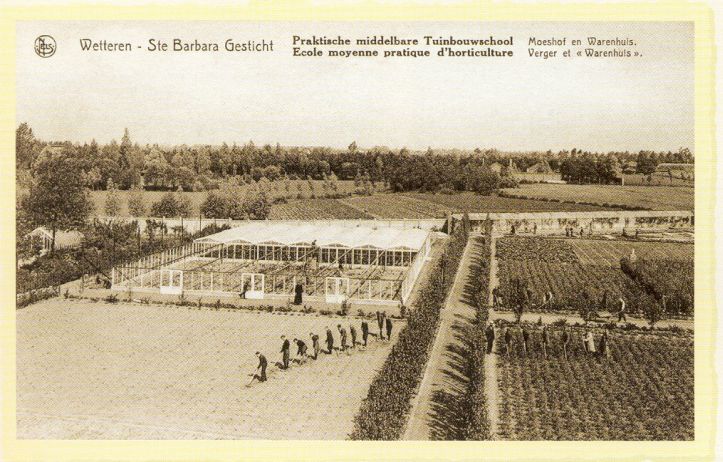
The number of pupils of the gardening division grew very quickly and Brother Rombaut Obbens came to help Brother Simon for the courses of plant pathology, chemistry and for demonstration courses. Soon, the school for horticulture got its own rooms and the breeding grounds were also extended.
In 1886 they asked for an extension of the buildings and Mgr. Lambrechts, Help Bishop of Gent, accepted this. It concerned the plans for the construction of the contemporary refectories of the primary school and the headmaster’s office, the former classes of the primary school on the first floor and the infirmary, the buildings that encircle the playground of the primary school together with the Chapel and the Convent .
A larger Public in the Boarding -School
In 1886, it was the first time that the boarding school accepted children who had no relation with the firm Cooppal. By this the boarding school became public for other orphans and abandoned boys.
24 May 1887 the large window-pane was placed above the choir in the chapel; it represented the litany of Our Holy Mary. That same day Brother Florent Labarre and Brother Gregoor Vinck came to Wetteren: this last one replaces Brother Emmanuel as the headmaster of the Institute. A few months later the highest room of the Chapel was also put in use.
More Brothers for a flourishing Institute
In 1891 the primary school had 6 classes and in 1892 it already had 130 orphans in the institute. In that same year, the professional divisions were open for the staff’s children of the factory as day pupils. In 1894 Sir Louis Schepens was appointed to be the chief of the garden in the horticultural division: he was responsible for the practice and for the apiculture.
Due to the constant growth of the number of orphans in the Institute and of the primary school children, the horticultural school and the professional school, more and more Brothers came to Wetteren to take care of the youth’s education.
The secondary school Saint-Peter
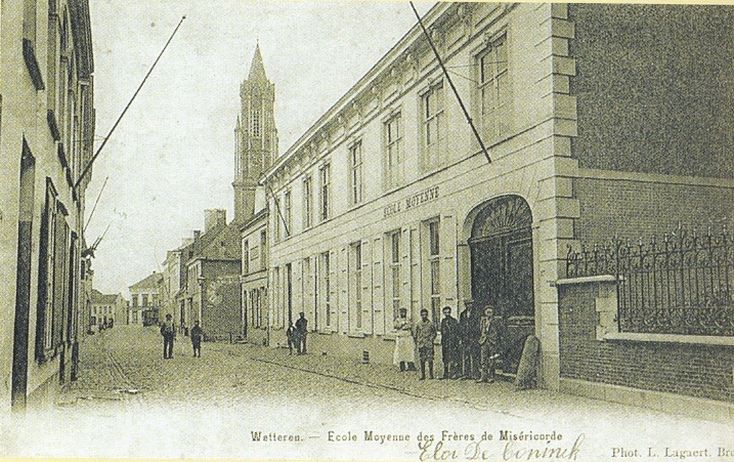
In 1894 Frederik Belpaire, Maria Teichmann’s husband, chairman of the Cooppal and Cie board, decided to build a secondary school for the citizen children of Wetteren. To realize this, the firm Cooppal bought the large notary house with the park of Sir Leirens, which was situated at the “Dendermondse- steenweg”, now the “Wegvoeringstreet”.
The Construction started immediately. The Scheppers’ Brothers were asked to take over the leading of this school as well. In the summer of 1895 the renovation works at the notary house were finished and in September the first lessons were thought. Brother Luciaan Wallemans, the first headmaster was also vice-principal of the Saint-Barbara Institute . The secondary school Saint-Peter (now the college Saint-Franciscus) was a fact.
Enlargement of the building complex
In 1897 the management board of the firm Cooppal decided to expand the existing buildings, meaning a working place for the new division “wood workmanship”, a workhouse for the clothing and the shoemaking, a laundry and a dormitory for the pupils.
The headmaster of the division “wood” became Sir Joseph Debosscher, structural contractor from Heusden who had already worked earlier for the firm Cooppal,. Later on he stayed working independently and because of the many tasks from the firm Cooppal, there was a lot of diversity as well in lessons as in constructions. At that same moment Ivo Pasques was also appointed to be a teacher in wood construction.
A model farm
On the suggestion of the inspector of agriculture then, the engineer, Paul De Vuyst, the Brother Congregation decided in 1899 to buy the grounds behind the chaplain’s house; a windmill that was constructed on these grounds was considered as a nice thing.
On their own costs a few buildings were raised to house the farm. In the year 1900 the buildings were finished. It became a farm that would be seen as a model for a lot of firms in the Flemish country. From the annals of that time, we mention the destination that was given to those buildings:
A pig’s stable: eight sties with a feeding corridor; a vaulted cow stable with 14 places to stay and a feeding place, a horse ’stable: two standing rooms with a feeding corridor; a dairy-farm, a cheese-making place; two cellars; a brewery: with machinery, a brace place and cooling place, an office and two fermentation cellars; a crusher place: cellar and ground floor, two stores and a corn ceiling with a production capacity of 40 sacks for baking meal and the necessary malt meal for the brewery; furthermore there were provision ceilings, storehouses, a stable for the ill and a chicken sty; a slaughterhouse; a bakery; a handcraft weaving place with three handcraft gears for winter work; a forge and a joinery for reparations.
Expansion of the humanity School Saint- Peter
At the beginning of the school year 1902-1903 Brother Simon became as well headmaster of the horticultural school as General Manager. Brother Rombaut left Saint-Barbara to found a separate community together with the Brothers Valentijn, Ladislaus, and Elzear at the Humanity School Saint-Peter in the center of Wetteren.
After they had already built another supplementary class at Saint-Peter, the year after, they already started a new floor above the existing classes. The necessary means were supplied by a benefactor from Dendermonde who wished to stay anonymous.
A new building for the primary school
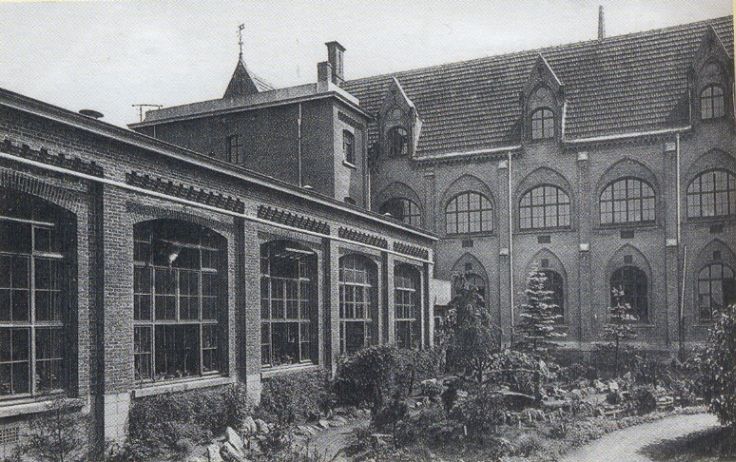
The primary school needed new and larger teaching rooms. Plans were designed and in 1911 they laid the first foundation stone of six classes and a feast hall ( the actual classes of the primary school on the ground floor and the feast hall- gymroom. It was Martha Liibbrecht, daughter of Henri Libbrecht, manager of the Cooppal factories who laid the first stone. They also paid the building that was constructed by the building contractor Alfred Braeckman.
The horticultural school expands
In 1913 before the new school year starts, Brother Hilaire Peeters came to Wetteren. Before he was a teacher in Scherpenheuvel and originally his family was a gardening family. He would become famous in Wetteren and surroundings and the horticultural school would reach unknown heights.
Under his driving power and with the approval of Brother Simon, they immediately started a new vegetable garden, a small model floriculture was founded and a new large nursery was constructed. That same year the architect Frans Van Severen was appointed to teacher of garden installation.
The First World War
In the beginning of 1914, more specifically on 25 January, the Congregation celebrated its 75th foundation birthday. But in that same year on 4th August, Belgium was invaded by the Germans troups of the emperor Willem II… Saint-Barbara counted 320 boarding pupils at that moment. At the start of the war, lots of orphans as well as most of the Brothers, fled to Watervliet.
Brother headmaster Simon De Roy stayed in Wetteren and that would become him fatal. The staff of Saint-Peter exchanged surprised Belgium for the much safer England; lots of Saint-Barbara’s boarding pupils followed this example. The withdrawn Belgian army braced oneself at the left bank of the Schelde.
Saint-Barbara became a barrack; but only for a short time because The German rolling machine wasn’t stopped by this stream. Even before the first shot was given, the Belgian army had evacuated the rooms of Saint-Barbara and a German company of pontoneers was billeted over there.
By the following hostilities the bridge over the Schelde was destroyed. That fact was the cause that Friar Jaak Massart who had fled from Scheppers-Mechelen, and who died 28th November 1914, was buried at the cemetery of Wetteren-ten Ede.
Survival in World War I
Wetteren was laying in the very closed “Etappen area”; This is the area behind the front where resting places and nursery places were settled. Saint-Barbara was partly occupied by the old people’s home from Roeselare and later also by that of Wetteren, both claimed by the occupier.
There were still about 80 orphans in Saint-Barbara; for most of them no more board was paid. The rationing was poor, the winter severe, pit-coal were rare, the financial situation desperate and the deportations of young people to Germany were always growing.
Nevertheless, lessons continued by all means and they tried to get through the years of war: the farm and the garden partly supplied the food supply.
A wood of Canada’s of about 1,5 ha, along the “Stookte street” was cut down to be used as fuel. On the cut down wood, one eyed slip potatoes cut from rationing potatoes, were planted. In the garden, tobacco and corn were cultivated. From the yield of tobacco 20000 kg. of potatoes were bought. Not an inch of the ground stayed bare.
To make the deportations undone
From the end of 1916, beginning of 1917, the deportations to Germany were always growing. Lots of bigger boys, even boarders, didn’t attend the lessons anymore because they feared to be picked up. One day the Institute was surrounded by armed soldiers. In the shortest time everybody had to be ready to leave. All of them were locked up somewhere in Laarne. Two Brothers freely accompanied the group of youngsters.
In the meanwhile a Brother had gone to the higher German board and that one was highly irritated because they were passed by. They immediately ordered to free the enclosed people. The day after, all our pupils had already joined another group of youngsters of about 200 people out of Gent, who were walking upon the road to Dendermonde under German leadership.. It was here that the Friar met them and showed the very disconcerted officer, the order. He then shouted: “You may return, all of you!”
The end of the Saint-Peter’s school
1916 meant the end of the presence of the Brothers in Saint-Pierre. For a very long time the ecclesiastical government in Wetteren wished to possess an episcopal college. After a few problems, the transition to the diocese has been realized without any interruption of the lessons.
The printing office and the farm on fire in 1920
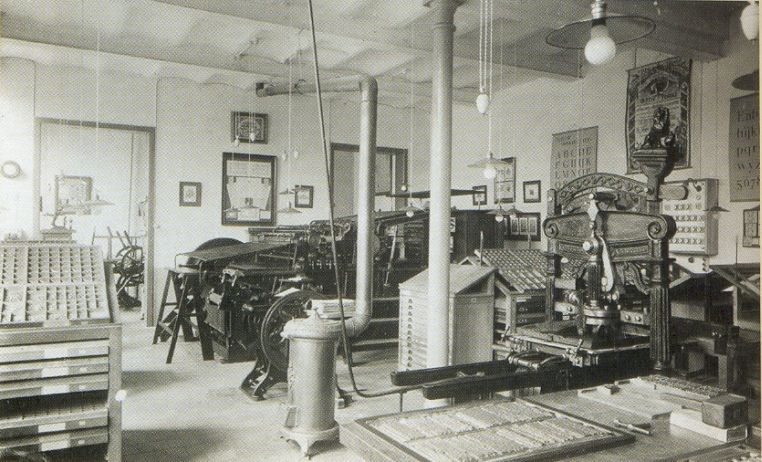
In 1920 the brewery was transformed into a printing office under the leadership of the Brothers Gabriël Goethaert and Polycarp Rosier. Already a few months later, this division was recognized. Before that the horticultural school, the cloth making, the shoe making and the wood making was also recognized; this meant that Saint-Barbara got allowances for all existing divisions.
In summer holidays of 1920, a fire broke out at the farm: forage and corn reserves vanished into smoke; although the cattle could be saved. To make things worse, the insurance premium wasn’t adapted after the war, so that little of the damage was compensated.
The horticultural school: a center of educa- tion
1923 was a pioneer year., not only for Saint-Barbara but under the force of Brother Hilaire also for the whole Flanders. In this blessed year, they started with a course in useful poultry farming. In the orchards they built appropriate poultry houses.
After a while, the secondary horticultural school of Wetteren became a center of education: first for its surroundings, later on for the whole province and finally for the whole Flemish country. The commercial poultry farms didn’t only bring a solution in the years of crisis, but they even brought welfare in lots of farming families and horticultural families as well.
The horticultural school at the World expo- sition
IIn September 1929 the General Land and Horticultural Exposition took place in Gent in the Old South Station. The provincial inspection wished to see a methodical exposition of the program by means of didactical elaborated lessons from all horticultural schools. There, Saint-Barbara got the price of honour of the secondary land and horticultural schools.
The next year the World expo would take place in Antwerp. During the expo in Gent, The established committee expressed its wish that the horticultural school of Wetteren would also take part in the World Expo 1930 in Antwerp.
During months they were travelling between Wetteren en Antwerp-South. Daily, at 8o’clock, the pupils and the teachers, lead by Brother Hilaire, left by a train which had two supplementary wagons. After months of hard work, they finished the job.
The model garden became successful; the horticultural school was the subject of different conversations. Brother Hilaire got different golden and silver medals.
A lot of visitors came to Wetteren
The result of this success at the Word expo in Antwerp was that lots of prominent people from inside the country as well as from outside, wanted to visit the school. Among them was the Egyptian Minister of agriculture, His Excellency Zakgel Ihachi, accompanied by the general governor of the Ministry of agriculture, Sir De Vuyst; the Minister of agriculture of Romania …
The Italian countess Valentina Visconti di Saliceto also visited the place. She even wanted to put one of her properties( situated in Monferato, near Milan) at the disposal of the Brothers to make a second Saint-Barbara of it. The superiors have not accepted that offer.
No single agricultural or horticultural school denied to visit Wetteren and this only with the purpose to gain all sorts of information. By the successes, gained in Antwerp, a very intense correspondence existed between Wetteren and the many interested: The Minister of agriculture asked for prospectuses and programs of the school; the same was asked by the board of the agricultural school of Geneva, Switzerland.
OInstead of the former greenhouse complex, a Flemish-Dutch architectural ornamental garden with a reservoir, fountains and pergola’s, was built, following a design of Brother Hilaire. Mgr. Coppieters, bishop of Gent, was one of the first who could behold this beautiful masterpiece during his visit.
A golden Jubilee in horticultural education

9 April 1933, the jubilee feast of 50 years horticultural education at Saint Barbara took place. During the reception at the Town Hall by Mayor Duchateau, Brother Superior and Brother Hilaire were worshipped. Brother Superior was no less than Brother Chrysostoom Landuyt, old pupil and old headmaster of Saint-Barbara. At that occasion, the printing-office of the school edited a memory album.
In the years after the Antwerp expo, still more glory and honour were given tot Brother Hilaire and his horticultural school. We only mention the most important ones: The “Gentse Floraliën” 1933; the “Interprovincial Fruit Exposition” in Gent 1934; The World Expo in Brussels 1935; the International Expo in Paris 1937; the “Gentse Floraliën” and the international Horticultural expo in Wetteren 1938.
Building again
Due to a lack of class rooms and work houses, the Brothers had to make plans to expand the buildings again and this for the seventh time. In the school year 1936-1937 the number of pupils had risen again to 131 in the technical school and to 74 in the horticultural school.
The building of 1926 was prolonged with three class rooms at the ground floor and three on the First floor; square to this, the new work house for wood construction was built. But, the new construction was stopped, unfinished, after the winter of 1939.
The second World War
10 May 1940, Belgium was pressed into a new World war. Teaching stopped and the boarders were send home. Lots of families fled to France; most of the Brothers accompanied them. Only six of them remained in Wetteren: the headmaster Brother Gelaas Smits; Brother Claudius Bosschaert, headmaster of the professional school; Brother Hilaire Peeters, headmaster of the horticultural school and the Brothers Benedictus Michiels, Florimond Rosier and Polycarp Rosier.
Saint- Barbara took care of bread, a shower and a place to sleep for all who knocked on their door. A heavy Belgian battery was charged to stop the German march on Dendermonde and Kwatrecht. For only four days they could stand firm. Wetteren was now an occupied zone and the war violence raged heavily over the “Westhoek”. When they saw the uselessness of further resistance, King Leopold III capitulated May 28.
A relative calmness reigned over Wetteren and lots of fugitives returned. The pupils were asked to return to school, but lots among them were too far away from home to be able to do that. Nevertheless at the end of the school year 1939-1040 the pupils were examined, but a few weeks later as usual.
More and more rooms were demanded by the occupier so that the new school year 1940-1941 started in rather strange circumstances. The summer holidays were prolonged till the beginning of October, also because the new building was not finished yet. October 2nd, the new buildings were ready and they could start with the removal of the working place for wood construction.
The winter of 1942-1943 was very severe, with strong night-frost and lots of snow. And it was still war. The pupils got free distributions of fish, olives, figs, soya biscuits and vitamins. City children came to Saint-Barbara to strengthen and this by an initiative of the organization “Winterhelp”. Day and night, the friars were besides them and accompanied them at sports, plays and wanderings; they also took care of the fact that the double ration which they were entitled to, was eaten.
The battle at Saint- Barbara’s
At the request of the Ministry of Education and by the mouth of Mgr. Coppieters, all Catholic schools were asked to stop teaching during May 1944: because of the heavy bombings by the allies, the pupils were requested to stay home just for safety reasons. The pupils of the last year came to school now and then and got the instructions as a preparation on their final exams that would take place on August 2nd.
June 6th 1944, the allies disembarked on the Normandy coasts. After heavy fights the Germans draw back and on September 4th, the first English tanks entered Wetteren.
In the early morning of September 6th, a German company tried to reach the bridge over the Schelde through the Beirstoppel district. An English tank division denied this and during that whole day a heavy battle was going on in Saint-Barbara’s neighbourhood. Four corn stacks vanished into smoke, Houwitzer grenades blew up the chapel’s walls, the farm and the printing-office. In the early evening the Germans surrendered; the whole neighbourhood was a desolated battle-field.
The growth of the School
At the start of the school year 1946-1947 Saint- Barbara counted 595 pupils; 108 of them were pupils from the horticultural school, 127 were destined for the professional school and 360 for the primary school.
Saint-Barbara’s farm seemed to be a great loss, despite all the medals and the distinctions for the cattle. All the cows and the bulls were sold. But, the crisis was only in the beginning and so within a couple of months all other activities on the farm stopped.
Where you can see the entrance gate and the reception of the technical Institute now, there were three small houses, which the firm Cooppal was owner from. These houses were almost encircled by the building complex of the horticultural school and the professional school. June 3rd 1947, the first house was bought by the friars. In view of a further expansion of the class rooms, the buying of these houses was absolutely necessary. Even before winter, the two other houses with grounds were bought at the Beirstoppelstreet.
The division “Fine Bakery” stopped at the start of the school year 1949-1950, despite the fact that at the end of the previous school year still 31 bakers got their final certificate.
At the end of 1949 the three houses they bought at the Beirstoppelstreet, were ready as class rooms for the professional school. Part of the dormitory was reformed into an auditory by Brother Valeer and this for the science courses.
Modernizing the shoe factory
April 18th 1951, the Constant Deputation of Eastern Flanders decided to take part for 100% in the purchase of 5 new machines for the shoe factory: a special machine with engine, a machine to split the soles, a groove machine, a polishing machine and a cutting machine.
At the start of the school year 1951-1952, they decided to stop teaching at the printing office division.
New divisions
In the beginning of the year 1952, new plans were made as the previous ones, although approved, were not carried out. At the end of February, the works finally started: 2 working places of 25 by 10 metres,. destined for the new divisions Mechanics and Electricity.
The necessary dossiers were presented as well for the recognition of the divisions Metal constructions and Electricity, for the recognition of 2 preparatory years, common for both divisions and for the reclaim of the Clothing division and the Shoe Factory. Now, the famous rise of the technical school started.
During the summer of 1953 the Town Council of Wetteren granted a gratification of 1000 000fr for the further extension of the school. It concerns the building along the Cooppal road.
Headmaster Friar Vital, the builder
In September 1954, Brother Vital Pellegrims was nominated headmaster of the professional school in succession of Brother Claudius Bosschaert who had managed the school for 25 years.

The first realizations of Brother Vital Pellegrims, concerned the horticulture: digging up old plantings, replacing the greenhouses and the rolling tanks, a new warehouse of 500square metres ( realized by the teachers and the pupils of the division Mechanics), the acquisition of a service car and the participation in the annual Flanders fair.
Brother Vital would go into history as a builder. The first symptoms of this expansion pressure, were already seen in the spring of 1957, when he contacted the provincial government for the construction of a gym hall, a hangar for wood, a bicycle store and the construction of a playground. And this was only the beginning: the following years would show that lots of construction projects would be realized under his skilful leadership.
During the school year 1957-1958, that started with 468 pupils, the following constructions were finished: a new playground was installed, new lavatories were put into use, the joinery was expanded till the Cooppal street and in the horticulture division, a new air-conditioned greenhouse for roses was built by teachers and pupils from the mechanical division.
At the end of that particular school year, the playground was put into use with a great spectacle on the Grand Place (Market) in Wetteren; afterwards, they marched towards the school, accompanied by the harmony of the Mechanical division in front of the procession. After the sport event and the presentation of the prizes, the statue of Saint-Joseph with a young labourer under his protecting hands, was unveiled by E.H. D’Hollander, dean of Wetteren. The statue, made from white art stone and cut by Sir De Bruyn from Aalst, is still in the pride of its beauty at the playground of our technical school.
Saint-Barbara in full expansion
In September 1958 the number of pupils grew from 469 to 547. This meant that al lot of teachers were enlisted and that they made plans, year after year for the expansion of the buildings. The new labour place for student-tailors was put into use at the Cooppal street and the shoe factory was replaced to the former buildings of the tailor students.
At the end of the school year 1958-1959, when the World Expo in Brussels was going on, again they started to construct in Wetteren: above the forge, a labour place and a class for electricity was built, and on top of the headmaster’s office, two stores were built: the first one destined as the secretariat and the second one as a library.
The First of September 1959 the school doors were reopened for 648 pupils, an augmentation of 101 in comparison with the previous year. The new constructions were not finished yet; so at the beginning of the year there was a space problem.
In November 1959 the Construction of the new gym hall started and before the end of that school year the leveling works for the large new building started so that the school was one big construction yard at that moment; at the same time three new constructions were to be realized. The last days of that school year and on the occasion of the horticultural feast, Brother Jaak De Winter, General Head, laid the foundation stone of the new building: one large hall, two ateliers.
By all sorts of circumstances, the new class rooms couldn’t put into use on the first of September, although they needed them badly because the number of the pupils was now above 700. They started with a division “weak current” on level 2.
On the occasion of the horticultural feast in 1962, the new building was consecrated by Monsignor De Wilde, Bishop of the missions, in the presence of lots of religious and civil authorities. A Gym feast and a Flemish fair attracted about 3000 people to Saint-Barbara.
Before the school year 1962-1963, all new rooms could be used: all painting classes were equipped, class rooms were furnished and working places were installed. Because of the multiplicity of rooms, the letter system was introduced for classes, labs and ateliers. The number of pupils always fluctuated around 700, at least for the moment... .
Host and a new name
In 1964, the Congregation of the Brothers of Scheppers was celebrating its 125th birthday. Wetteren was the host of the Congress about the “Para scholar” Institutions: associations of friends, groups of parents and old pupils of all the friars schools out of the Belgian Province.
An exhibition "Mgr. Scheppers and his Brothers” as well as the inauguration of a new glass window in the chapel were other culminating points of this memorable commemoration. The Beirstoppel street became the Cooppalstreet and the Technical schools Saint-Barbara were baptized as “The Technical Institute Scheppers”.
Further enlargement
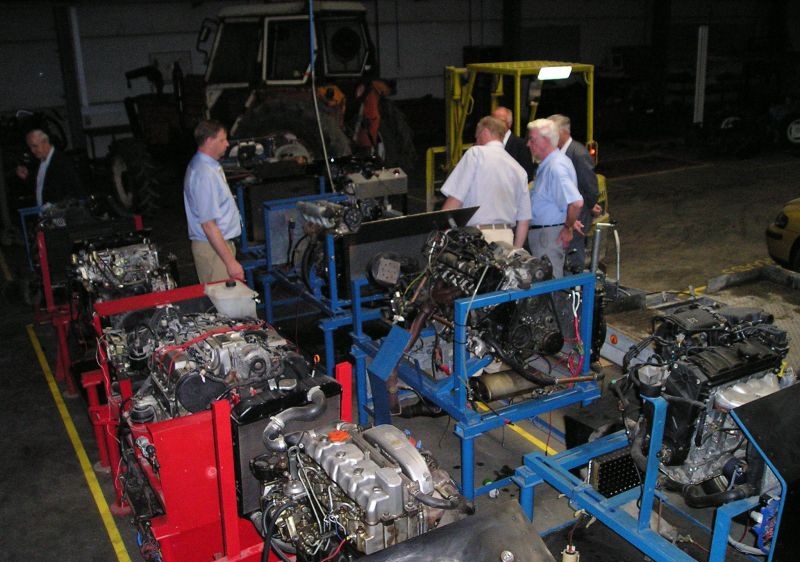
Recruitment difficulties in the shoe factory division urged to the gradual closing from 1968 onwards. The four years “shoe factory” were replaced in 1969 by a specialization year “”Car Mechanics” A3 and by the division lead and zinc, on the higher professional secondary level, and that as the first one in Belgium.
In January 1974 they laid the foundation stone of the complex near the Stooktestreet. As well for study as for sportst : they built: a working house for the specialization “car mechanics”, a class for the theoretical lessons, a practicum “Pneumatics” and a large sports hall.
What nobody expected and didn’t even think of, happened nevertheless: the school population was still rising to 947 in 1978 so that they had to think again about new constructions. In September 1978 the last construction yard was broken up: a second floor above the building of 1926 was now used as a lab for “Electronics”, a painting class and a class room. The teachers meanwhile could remain in a nice and well adapted teachers’ room, although the winter garden had to be given up therefore.
Toddlers and girls

The 1st September 1967 the boys and girls school of “Gransvelde” (Kerkwegel) was made over by official act to Saint-Barbara. The number of pupils exceeded the 300 cape and Sir Galle became headmaster without a class.
For the First time our schools didn’t count more than 1000 pupils in general and the toddlers entered the Cooppalstreet; the primary school was now approachable for girls as well.
In 1969 a boarder dormitory was modified into three classes for the primary school. They were leaving the rooms of the technical institute where they also needed rooms badly.
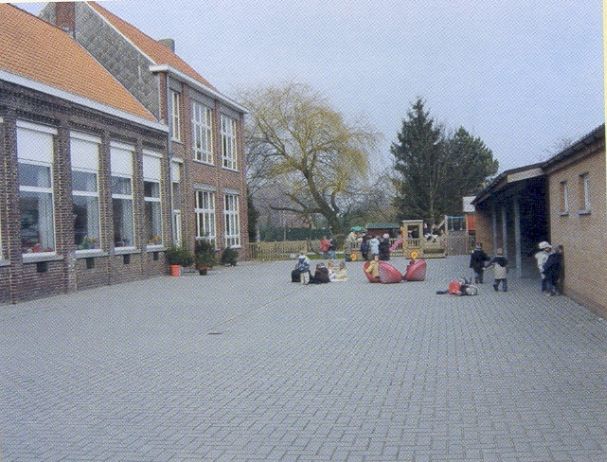
The boarding school was officially recognized as “a boarding school for children whose parents had no steady abode”, (= the official name). The first boarder manager was Brother David Van de Leur who was in charge in Saint-Pieters in 1913 and who returned to Wetteren after a long stay in Canada.
In 1973 the fusion of the municipal schools of Kapellendries en Ten-Ede with Saint-Barbara became a fact. Meanwhile the elementary school was extended with six classes on the first floor. This was “a scoop” for Wetteren; they built with a guarantee fund of the Government.
The foundation-stone of the new building
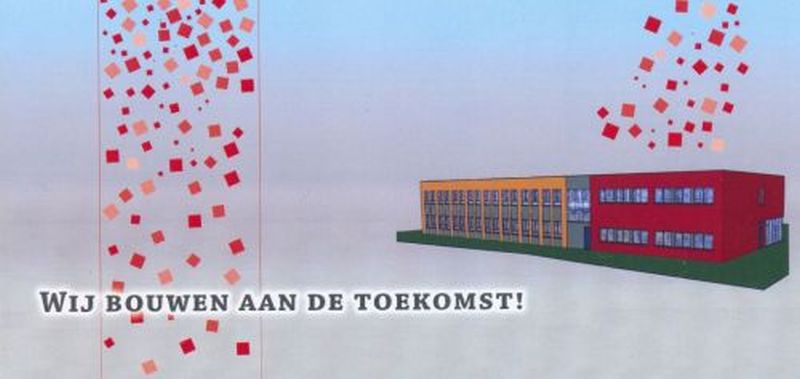
Because of the constant growth of the number of pupils, the Scheppers Institute of Wetteren often needs more rooms. Therefore the complex of the building was continuously extended. In 2008 they again needed more rooms. This time, the Institute had started a unique project. With the help of their own pupils and their own teachers, they constructed a new building of 19 class rooms and a dining-room. The further finishing is also done by the pupils and their teachers. No building contractor has ever been asked, the architect is the only outsider.
In two years time the new building should be ready for use. The present-day pupils are motivated enough because they even spend their free Wednesday afternoons on the yard. On their own construction yard they obtain a rich experience: real “work place learning”!
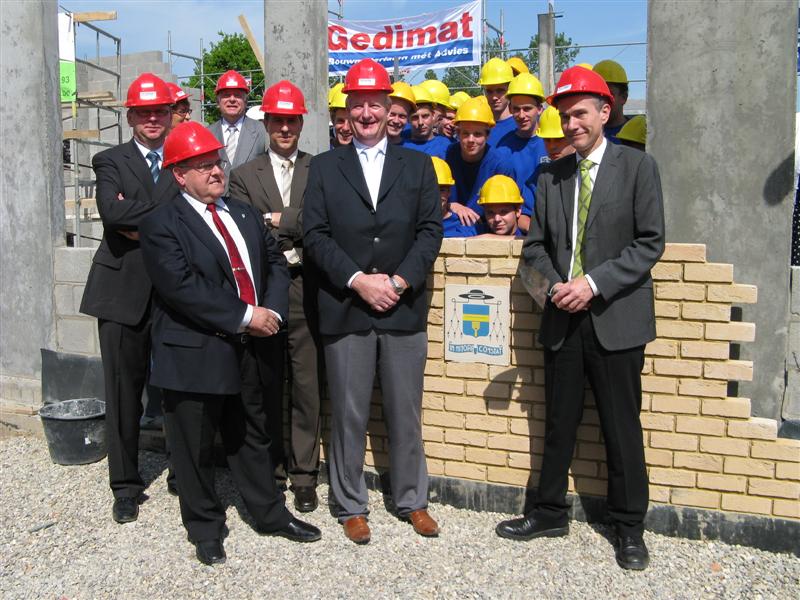
Saturday, the 1st May, the foun- dation-stone of this new complex for the first degree was symbolically laid in the presence of our Flemish Minister of Education Frank Vandenbroucke.
This event took place under a beaming spring sun in the presence of the board, the teachers, the pupils and the parents of 6BO and lots of guests.
In the morning, an academic session was hold concerning the famous “work place-learning”, followed by a symbolic foundation-stone laying. They finished with a reception given by the pupils of “Mariagaard”.
VTM-news was there.
Sources: Scheppers- Wetteren-100 years- 1879-1979 and 125 years Scheppers





